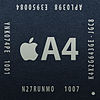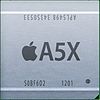Apple silicon
Apple System on Chips, Ax, is a series of ARM-based SoCs designed for use in Apples consumer electronic devices, such as the iPod, iPad, iPhone and Apple TV.
Apple A4
The Apple A4 is a package on package (PoP) system-on-a-chip (SoC) designed by Apple and manufactured by Samsung.[1] It combines an ARM Cortex-A8 CPU with a PowerVR GPU, and emphasizes power efficiency.[2] The chip commercially debuted with the release of Apple's iPad tablet;[3] followed shortly by the iPhone 4 smartphone,[4] the 4th generation iPod Touch and the 2nd generation Apple TV. It was superseded in the second-generation iPad, released the following year, by the Apple A5 processor.
Apple A4 is based on the ARM processor architecture.[5] The first version released ran at 1 GHz for the iPad and contains an ARM Cortex-A8 CPU core paired with a PowerVR SGX 535 graphics processor (GPU)[3][6][7][8] built on Samsung's 45-nanometer (nm) silicon chip fabrication process.[9] The clock speed for the units used in the iPhone 4 and the iPod Touch (4th generation) is 800 MHz. The clock speed for the unit used in the Apple TV has not been revealed.
The Cortex-A8 core used in the A4 is thought to use performance enhancements developed by chip designer Intrinsity (which was subsequently acquired by Apple)[10] in collaboration with Samsung.[11] The resulting core, dubbed "Hummingbird", is able to run at far higher clock rates than other implementations while remaining fully compatible with the Cortex-A8 design provided by ARM.[12] Other performance improvements include additional L2 cache. The same Cortex-A8 CPU core used in the A4 is also used in Samsung's S5PC110A01 SoC.[13][14] The SGX535 in the A4 could push 35 million polygons/second and 500 million pixels/second, although in real world tests it struggled to pull off even 7 million flat shaded polygons.[15]
The A4 processor package does not contain RAM, but supports PoP installation. The top package of the A4 used in the iPad, in the iPod Touch[16] 4th gen and in the Apple TV[17] 2nd gen contains two low-power 128 MB DDR SDRAM chips for a total of 256MB RAM. For the iPhone 4 there are two chips of 256 MB for a total of 512 MB.[18][19][20] RAM is connected to the processor using ARM's 64-bit-wide AMBA 3 AXI bus. This is twice the width of the RAM data bus used in previous ARM 11 and ARM 9 based Apple devices, to support the greater need for graphics bandwidth in the iPad.[21]
Apple A5
The Apple A5 is a package on package (PoP) system-on-a-chip (SoC) designed by Apple and manufactured by Samsung[22] that replaced the A4. The chip commercially debuted with the release of Apple's iPad 2 tablet in March 2011,[23] followed by its release in the iPhone 4S smartphone later that year. (This is consistent with how Apple debuted the A4 chip: first in the original iPad, then in the iPhone 4, and finally in the 4th generation iPod touch.[24])
The A5 contains a dual-core ARM Cortex-A9 CPU[25] with ARM's advanced SIMD extension, marketed as NEON, and a dual core PowerVR SGX543MP2 GPU. This GPU can push between 70 and 80 million polygons/second and has a pixel fill rate of 2 billion pixels/second. Apple lists the A5 to be clocked at 1 GHz on the iPad 2's technical specifications page,[26] though it can dynamically adjust its frequency to save battery life.[25][27] The clock speed of the unit used in the iPhone 4S is 800 MHz.
Apple claims that the CPU is twice as powerful and the GPU up to nine times as powerful as its predecessor, the Apple A4. The A5 package contains 512 MB of low-power DDR2 RAM.[28] The A5 is estimated to cost 75% more than its predecessor; the price difference is supposed to diminish as production increases.[29]
The third generation Apple TV and the new version of iPad 2 (version iPad2,4) contains a 32 nm version of the A5 processor. The chip in the Apple TV has one core disabled.[30][31] The markings of the square package indicates that it's named APL2498, and in software, the chip is called S5L8942. The 32 nm variant of the A5 provides around 15% better battery life during web browsing, 30% better when playing 3D games and approximately 20% better battery life during video playback.[32]
Apple A5X
Apple A5X was announced on March 7, 2012 at the launch of the iPad (3rd generation). This SoC has a quad-core graphics unit (PowerVR SGX543MP4) instead of the previous dual-core as well as a quad-channel memory controller that provides a memory bandwidth of 12.8 GB/sec, roughly three times more than in the A5. The added graphics cores and extra memory channels add up to a very large die size of 163 mm², for example twice the size of Nvidia Tegra 3.[33] This is mainly due to the large PowerVR SGX543MP4 GPU. The clock frequency of the dual ARM Cortex-A9 cores have been shown to operate at the same 1 GHz frequency as in A5.[34] The RAM in A5X is separate from the main CPU package.[35]
Apple A6
The Apple A6 was announced on September 12, 2012 at the launch of the iPhone 5. It is 22% smaller, twice as fast, has twice the graphic performance, and draws less power than the 45nm A5.[36] The CPU uses a modified ARM instruction set called ARMv7s[37] which means that the CPU is not a strict ARM licensed CPU but instead a custom built ARM Cortex like CPU, similar to how Qualcomm makes CPUs. The support for VFPv4 extensions suggests that it is a Cortex-A15 class CPU. The GPU is a triple core PowerVR SGX543MP3 running at 266 MHz.
Apple A6X
The Apple A6X was introduced with the fourth generation iPad in October 2012. It has dual Swift cores, just as the A6, but has a new quad core GPU and higher clock speed.
According to Anandtech and ChipWorks, maximum clock speed is 1.4 GHz, and GPU is PowerVR SGX554MP4.[38][39]
List of Apple SoCs
| Name | Model no. | Image | Semiconductor technology | Die size | CPU ISA | CPU | CPU cache | GPU | Memory technology | Introduced | Utilizing devices |
|---|---|---|---|---|---|---|---|---|---|---|---|
| APL0098 | 90 nm | ARMv6 | 412 MHz single-core ARM11 | L1: 16 kB Instruction + 16 kB Data | PowerVR MBX Lite @ 103 MHz | 32-bit Single-channel 103 MHz LPDDR | June 2007 |
| |||
| APL0278 | 65 nm | ARMv6 | 412–533 MHz single-core ARM11 | L1: 16 kB Instruction + 16 kB Data | PowerVR MBX Lite @ 103–133 MHz | 32-bit Single-channel 133 MHz LPDDR | September 2008 |
| |||
| APL0298 | 65 nm | 71.8 mm2 | ARMv7 | 600 MHz single-core Cortex-A8 | L1: 32 kB Instruction + 32 kB Data, L2: 256 kB | PowerVR SGX535 @ 150 MHz (1.2 GFLOPS) | 32-bit Single-channel 200 MHz LPDDR (1.6 GB/sec) | June 2009 | |||
| APL2298 | 45 nm | ARMv7 | 600–800 MHz single-core Cortex-A8 | L1: 32 kB Instruction + 32 kB Data, L2: 256 kB | PowerVR SGX535 @ 150–200 MHz (1.2–1.6 GFLOPS) | 32-bit Single-channel 200 MHz LPDDR (1.6 GB/sec) | September 2009 |
| |||
| A4 | APL0398 | 
|
45 nm | 53.29 mm2 | ARMv7 | 0.8–1.0 GHz single-core Cortex-A8 | L1: 32 kB Instruction + 32 kB Data, L2: 512 kB | PowerVR SGX535 @ 200–250 MHz (1.6–2 GFLOPS)[40] | 32-bit Dual-channel 200 MHz LPDDR (3.2 GB/sec) | March 2010 |
|
| A5 | APL0498 | 
|
45 nm | 122.6 mm2 | ARMv7 | 0.8–1.0 GHz dual-core Cortex-A9 | L1: 32 kB instruction + 32 kB data, L2: 1 MB | PowerVR SGX543MP2 (dual-core) @ 200–250 MHz (12.8–16 GFLOPS)[40] | 32-bit Dual-channel 400 MHz LPDDR2 (6.4 GB/sec) | March 2011 | |
| APL2498 | 
|
32 nm HKMG | 71.1 mm2 | ARMv7 | 0.8–1.0 GHz dual-core Cortex-A9 (one core disabled in Apple TV) | L1: 32 kB instruction + 32 kB data, L2: 1 MB | PowerVR SGX543MP2 (dual-core) @ 200–250 MHz (12.8–16 GFLOPS)[40] | 32-bit Dual-channel 400 MHz LPDDR2 (6.4 GB/sec) | March 2012 |
| |
| A5X | APL5498 | 
|
45 nm | 162.94 mm2[33] | ARMv7 | 1.0 GHz dual-core Cortex-A9 | L1: 32 kB instruction + 32 kB data, L2: 1 MB | PowerVR SGX543MP4 (quad-core) @ 250 MHz (32 GFLOPS)[40] | 32-bit Quad-channel 400 MHz LPDDR2[41] (12.8 GB/sec) | March 2012 |
|
| A6 | APL0598 | 
|
32 nm HKMG[42] | 96.71 mm2[42] | ARMv7s | 1.3 GHz[43] dual-core Swift[44] | L1: 32 kB instruction + 32 kB data, L2: 1 MB[45] | PowerVR SGX543MP3 (triple-core) @ 266 MHz (25.5 GFLOPS)[46] | 32-bit Dual-channel 533 MHz LPDDR2[47] (8.5 GB/sec) | September 2012 | |
| A6X | APL5598 | 
|
32 nm HKMG[39] | 123 mm2[39] | ARMv7s | 1.4 GHz dual-core Swift[38] | L1: 32 kB instruction + 32 kB data, L2: 1 MB | PowerVR SGX554MP4 (quad-core) @ 300 Mhz (76.8 GFLOPS)[48][38] | 32-bit Quad-channel LPDDR2[39] | October 2012 |
See also
- List of Samsung system on chips
- Allwinner
- ARM Cortex-A9 MPCore
- PowerVR SGX GPUs were also used in the iPhone 3GS and the third-generation iPod Touch
- PWRficient, a processor designed by P.A. Semi, a company Apple acquired to form an in-house custom chip design department
- Rockchip
Similar platforms
- Exynos by Samsung
- Snapdragon by Qualcomm
- Atom by Intel
- NovaThor by ST-Ericsson
- OMAP by Texas Instruments
- Tegra by Nvidia
References
- ^ Clark, Don (2010-04-05). "Apple iPad Taps Familiar Component Suppliers - WSJ.com". Online.wsj.com. Retrieved 2010-04-15.
- ^ "iPad - It's thin, light, powerful, and revolutionary". Apple. Archived from the original on 6 July 2010. Retrieved 2010-07-07.
{{cite web}}: Unknown parameter|deadurl=ignored (|url-status=suggested) (help) - ^ a b "Apple Launches iPad" (Press release). Apple. 2010-01-27. Archived from the original on 30 January 2010. Retrieved 2010-01-28.
{{cite press release}}: Unknown parameter|deadurl=ignored (|url-status=suggested) (help) - ^ "iPhone 4 design". Apple. 2010-07-06.
- ^
Vance, Ashlee (2010-02-21). "For Chip Makers, the Next Battle Is in Smartphones". New York Times. Archived from the original on 25 February 2010. Retrieved 2010-02-25.
{{cite news}}: Unknown parameter|deadurl=ignored (|url-status=suggested) (help) - ^ Wiens, Kyle (2010-04-05). "conclusion from both hard and software analysis it uses an ARM Cortex-A8 core". Ifixit.com. Archived from the original on 18 April 2010. Retrieved 2010-04-15.
{{cite web}}: Unknown parameter|deadurl=ignored (|url-status=suggested) (help) - ^ "iPad — Technical specifications and accessories for iPad". Apple. Archived from the original on 30 January 2010. Retrieved 2010-01-28.
{{cite web}}: Unknown parameter|deadurl=ignored (|url-status=suggested) (help) - ^ Melanson, Donald (2010-02-23). "iPad confirmed to use PowerVR SGX graphics". Engadget.
- ^ "Chipworks Confirms Apple A4 iPad chip is fabbed by Samsung in their 45-nm process". Chipworks.
- ^ Stokes, Jon (2010-04-28). "Apple purchase of Intrinsity confirmed". Ars Technica. Archived from the original on 28 April 2010. Retrieved 2010-04-28.
{{cite web}}: Unknown parameter|deadurl=ignored (|url-status=suggested) (help) - ^ Merritt, Rick. "Samsung, Intrinsity pump ARM to GHz rate". EETimes.com. Retrieved 2010-04-23.
- ^ Keizer, Gregg (2010-04-06). "Apple iPad smokes past the iPhone 3GS in speed". PC World. Archived from the original on 20 April 2010. Retrieved 2010-04-11.
{{cite web}}: Unknown parameter|deadurl=ignored (|url-status=suggested) (help) - ^ Boldt, Paul; Scansen, Don; Whibley, Tim (16 June 2010). "Apple's A4 dissected, discussed...and tantalizing". EETimes.com. Retrieved 2010-07-07.
- ^ "Microsoft PowerPoint - Apple A4 vs SEC S5PC110A01" (PDF). Archived from the original (PDF) on 4 July 2010. Retrieved 2010-07-07.
{{cite web}}: Unknown parameter|deadurl=ignored (|url-status=suggested) (help) - ^ "Apple iPad 2 GPU Performance Explored: PowerVR SGX543MP2 Benchmarked - AnandTech :: Your Source for Hardware Analysis and News". AnandTech. Archived from the original on 18 March 2011. Retrieved 2011-03-15.
{{cite web}}: Unknown parameter|deadurl=ignored (|url-status=suggested) (help) - ^ "Teardown of Apple's 4th-gen iPod touch finds 256MB of RAM". Appleinsider.com. 2010-09-08. Archived from the original on 11 September 2010. Retrieved 2010-09-10.
{{cite web}}: Unknown parameter|deadurl=ignored (|url-status=suggested) (help) - ^ "Apple TV 2nd Generation Teardown". iFixit. 2010-09-30. Archived from the original on 2 January 2011. Retrieved 2011-01-04.
{{cite web}}: Unknown parameter|deadurl=ignored (|url-status=suggested) (help) - ^ "Apple reveals iPhone 4 has 512MB RAM, doubling iPad - report". Appleinsider.com. 2010-06-17. Archived from the original on 4 July 2010. Retrieved 2010-07-07.
{{cite web}}: Unknown parameter|deadurl=ignored (|url-status=suggested) (help) - ^ "A Peek Inside Apple's A4 Processor". iFixit. 2010-04-05.
- ^ Greenberg, Marc (2010-04-09). "Apple iPad: no LPDDR2?". Denali.
- ^ Merritt, Rick (2010-04-09). "iPad equipped to deliver richer graphics". EE Times Asia. Retrieved 2010-04-14.
- ^ "Updated: Samsung fabs Apple A5 processor". EETimes.com. March 12, 2011. Retrieved 2011-03-15.
- ^ "Apple Announces iPad 2 with New Design, Faster A5 Processor".
- ^ "iPhone 5 expected to have same A5 chip as iPad 2". Macworld.co.uk. Retrieved 2012-01-25.
- ^ a b "Apple iPad 2 Preview - AnandTech :: Your Source for Hardware Analysis and News". AnandTech. Retrieved 2011-03-15.
- ^ "iPad - View the technical specifications for iPad". Apple. Archived from the original on 16 March 2011. Retrieved 2011-03-15.
{{cite web}}: Unknown parameter|deadurl=ignored (|url-status=suggested) (help) - ^ "Inside Apple's iPad 2 A5: fast LPDDR2 RAM, costs 66% more than Tegra 2". AppleInsider. Retrieved 2011-03-15.
- ^ "Apple iPad 2 feature page". Apple.com. Archived from the original on 16 March 2011. Retrieved 2011-03-15.
{{cite web}}: Unknown parameter|deadurl=ignored (|url-status=suggested) (help) - ^ Pascal-Emmanuel Gobry (14 March 2011). "It Costs $326.60 To Make An iPad 2 — Why That Matters". Business Insider, Inc. Retrieved March 14, 2011.
- ^ Single-core A5 CPU in new 1080p Apple TV doubles RAM to 512MB
- ^ "Update – 32-nm Apple A5 in the Apple TV 3 – and an iPad 2!". http://www.chipworks.com. Chipworks. 2012-04-11. Retrieved 2012-04-12.
{{cite web}}: External link in|work= - ^ "The iPad 2,4 Review: 32nm Brings Better Battery Life". AnandTech. Retrieved 2012-11-01.
- ^ a b "Apple A5X Die Size Measured: 162.94mm^2, Samsung 45nm LP Confirmed". AnandTech. Retrieved 2012-11-01.
- ^ "The Frequency of Apple A5X in the New iPad Confirmed: Still Running at 1GHz". AnandTech. Retrieved 2012-11-01.
- ^ "iFixit teardown of the 3rd generation iPad". iFixit.
- ^ Apple: A6 chip in iPhone 5 has 2x CPU power, 2x graphics performance, yet consumes less energy
- ^ Lal Shimpi, Anand (September 15, 2012). "The iPhone 5's A6 SoC: Not A15 or A9, a Custom Apple Core Instead". AnandTech. Retrieved September 15, 2012.
- ^ a b c iPad 4 GPU Performance Analyzed: PowerVR SGX 554MP4 Under the Hood // Anandtech, Anand Lal Shimpi, 02-11-2012 "A6X ... integrates two of Apple's new Swift cores running at up to 1.4GHz... The A6X moves to a newer GPU core: the PowerVR SGX 554."
- ^ a b c d Inside the Apple iPad 4 – A6X a very new beast!
- ^ a b c d Lal Shimpi, Anand (Sep, 2012). "The iPhone 5 Performance Preview". AnandTech. Retrieved October 24, 2012.
{{cite web}}: Check date values in:|date=(help) - ^ "The Apple iPad Review (2012)". AnandTech. Retrieved 2012-11-01.
- ^ a b Apple A6 Teardown
- ^ "The iPhone 5 Performance Preview". AnandTech. Retrieved 2012-11-01.
- ^ Lal Shimpi, Anand (September 15, 2012). "The iPhone 5's A6 SoC: Not A15 or A9, a Custom Apple Core Instead". AnandTech. Retrieved September 15, 2012.
- ^ iPhone 5 Benchmarks Appear in Geekbench Showing a Dual Core, 1 GHz A6 CPU
- ^ Apple A6 Die Revealed: 3-core GPU, < 100mm^2
- ^ Shimpi, Anand Lal; Klug, Brian (September 15, 2012). "iPhone 5 Memory Size and Speed Revealed: 1 GB LPDDR2-1066". AnandTech. Retrieved September 16, 2012.
- ^ [http://www.glbenchmark.com/phonedetails.jsp?benchmark=glpro25&D=Apple+iPad+4&testgroup=gl GLBenchmark - Apple iPad 4
